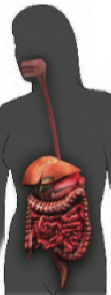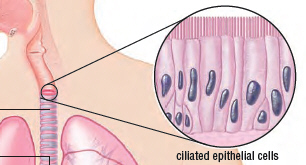Multiple Choice
Identify the
choice that best completes the statement or answers the question.
|
|
|
1.
|
Which system is illustrated in the diagram shown below?  a. | nervous | b. | endocrine | c. | digestive | d. | circulatory |
|
|
|
2.
|
A person who experiences dizziness associated with low blood sugar may have a
disease that affects which organ(s)?
a. | pancreas | b. | liver | c. | gall
bladder | d. | all of the above |
|
|
|
3.
|
The tongue, esophagus, and intestines of a human would all be considered parts
of a(n)
a. | organ | b. | organ system | c. | tissue
system | d. | team |
|
|
|
4.
|
The four major types of tissue that animals have include all of the following,
except:
a. | epithelial | b. | connective | c. | muscle | d. | brain |
|
|
|
5.
|
A cell that can differentiate into many different cell types in an animal is
called a
a. | specialized cell | b. | stem cell | c. | tissue | d. | daughter cell |
|
|
|
6.
|
Hemoglobin allows red blood cells to
a. | transport oxygen | b. | destroy bacteria | c. | clot | d. | be transported |
|
|
|
7.
|
The heart is composed of all of the following tissues, except
a. | connective | b. | muscle | c. | epithelial | d. | nerve |
|
|
|
8.
|
What is a purpose of the cells shown in the diagram below?  a. | produce saliva to aid in digestion | b. | filter out any foreign material that might
enter the system | c. | keep the trachea closed when swallowing | d. | induce the gag
reflex |
|
|
|
9.
|
Which of the following is a connective
tissue? a. | Veins | b. | Neurons | c. | Bone | d. | Epithelium |
|
|
|
10.
|
What type of blood cell fights disease- causing viruses and
bacteria?
a. | Red blood cell | b. | White blood cell | c. | Platelets | d. | Plasma |
|
|
|
11.
|
Which of the following is a large blood vessel that carries blood toward the
heart?
a. | Artery | b. | Vein | c. | Capillary | d. | Chamber |
|
|
|
12.
|
Which of the following is NOT a type of muscle tissue?
a. | Smooth | b. | Skeletal | c. | Tendon | d. | Cardiac |
|
|
|
13.
|
What is the function of the epithelial tissue?
a. | To support, protect, and connect the body’s tissue? | b. | To cover body
surfaces and line internal organs | c. | To contract and produce
movement | d. | To sense information about our surroundings |
|
|
|
14.
|
Which of the following organs produces a chemical called insulin that helps
cells use glucose?
a. | Stomach | b. | Liver | c. | Pancreas | d. | Gall bladder |
|
|
|
15.
|
The hierarchy of organization in an animals is
a. | Tissue > Cells > Organs > Organ Systems > Organism | b. | Organism > Organ
Systems > Organs> Tissues > Cells | c. | Cells > Organs > Tissues > Organ
systems > Organism | d. | Cells > Tissues > Organs > Organ
Systems > Organism |
|